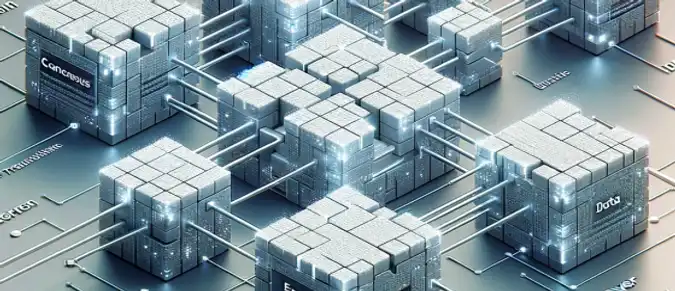The three main attributes of any blockchain system — are its scalability, security, and decentralization. According to the blockchain trilemma principle, it is difficult to perfectly balance all three qualities, and usually, one of them has to be sacrificed for the others.
The main focus in the blockchain community is traditionally on security, as seen in networks like Ethereum and Bitcoin. However, their limited throughput becomes an increasingly noticeable problem as the number of users grows, hindering the widespread adoption of the technology.
Innovative ideas and approaches are proposed to solve this problem. Among them, modularity stands out, which many experts, including Vitalik Buterin, consider a defining factor for the future development of blockchains.
- Basics of Modular Blockchain
- Foundations for the Development of Modular Blockchains
- Modular Blockchain Ecosystem
- Understanding Modularity Evolution
Basics of Modular Blockchain
To function properly, a decentralized network must ensure three critical functions:
- Consensus: nodes in the network must agree on the state of the network, maintaining unity and order.
- Transactional Processing: execution and recording of operations, as well as updating the network state information.
- Data Storage: maintaining records of transactions to enable the restoration of the blockchain's history.
Some experts emphasize the importance of the so-called settlement or conflict resolution function, which ensures the finality of completed transactions and serves for arbitration in case of disputes about their legality. In traditional, monolithic blockchains, this function is integrated with the consensus mechanism and is not considered an independent component. However, in modular blockchains, it can be implemented as a separate module, providing flexibility in its application.
Participating in the process:
- Executors, forming blocks by hashing transactions and updating the network state.
- Nodes, reaching consensus on new transactions, approving or rejecting them.
The last step is for nodes to store approved blocks for access and validation.
This interconnection between nodes is critical for validating transactions and maintaining the network's currency.
In monolithic blockchains, all nodes perform these tasks, making the network secure but less scalable.
The modular blockchain offers an alternative, separating these functions into distinct modules, each specialized for a specific task. This promotes flexibility and scalability, allowing for the optimization and addition of new layers as needed.

Each level functions as an independent module, specialized for performing specific functions. These modules can interact and unite to form a complete system.
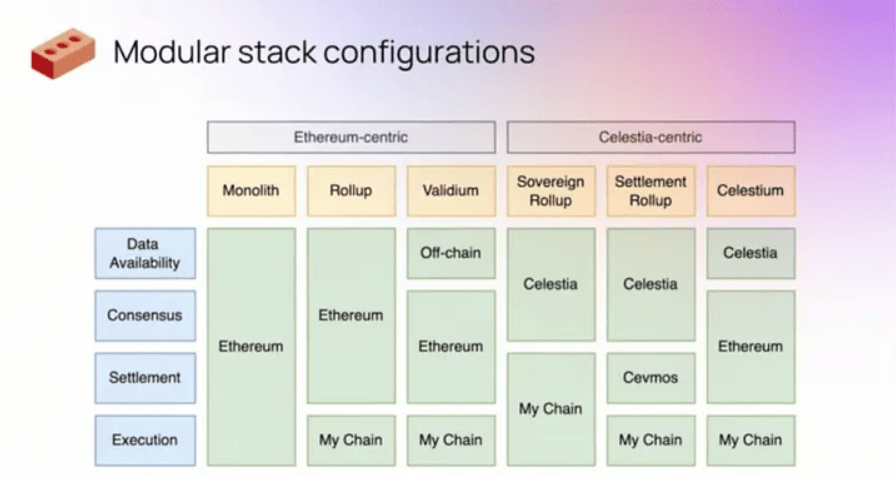
This idea facilitates specialization, as individual modules, tailored to perform specific tasks, can serve different levels of the network. This improves scalability through the possibility of optimizing nodes and implementing new modules.
It is important to distinguish between a modular network and a modular ecosystem. The modular network is associated with projects that provide a composable level of consensus and data access, such as Celestia, which can also support execution nodes.
In a broader sense, the modular ecosystem encompasses solutions for transaction processing, like rollups, conflict resolution mechanisms, and other aspects. Thus, the modular blockchain is formed from these complementary levels, similar to "Lego".
Foundations for the Development of Modular Blockchains
Modular blockchains, while not new to the cryptocurrency market, have significantly transformed their concept over time. Among the pioneers in this segment are Cosmos and Polkadot, which debuted in 2019 and 2020 respectively. Initially, they were aimed at facilitating interaction between different blockchains, but over time they shifted focus towards modularity.
Interest in modular architectures was revived after the hype around Cosmos, and the emergence of first-level monolithic blockchains (L1) like Solana, Fantom, and Near. What prompted developers to revisit the modular structure? There are several reasons for this.
Overcoming the Blockchain Trilemma
The concept of the blockchain trilemma, formalized by Vitalik Buterin in 2017, highlights the problems of existing networks at the beginning of the article.
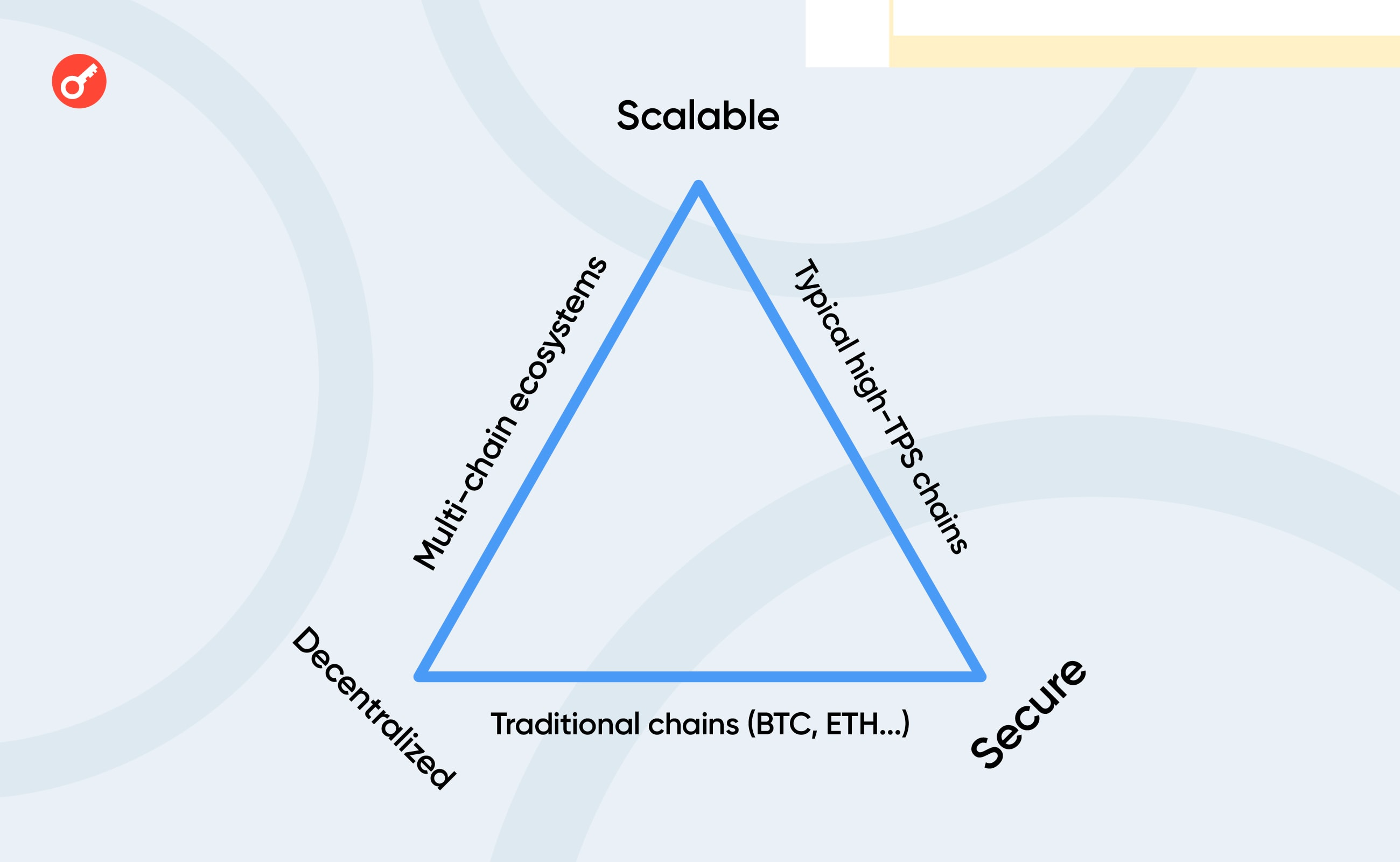
The schematic representation of the blockchain trilemma illustrates the difficulty of simultaneously achieving scalability, security, and decentralization. The attempts following Ethereum to create so-called "Ethereum killers" have not yet provided a definitive solution to this dilemma:
- Ethereum still suffers from low speed;
- Solana remains centralized;
- Cosmos-based networks have security vulnerabilities.
Over time, it became clear that monolithic blockchains could not find a balance in the trilemma, leading to a decline in their development activity.
The search for solutions turned towards modular networks, stimulated by the successes of Cosmos and Polkadot, as well as the emergence of second-layer solutions (L2) and the development of Celestia as a modular consensus layer.
Example of Ethereum
Ethereum plays a leading role in popularizing modular networks. Currently, this blockchain remains monolithic, but the strategy developed by Buterin in 2021 envisages a gradual separation of functions between different types of nodes. This process is detailed in the project's roadmap.
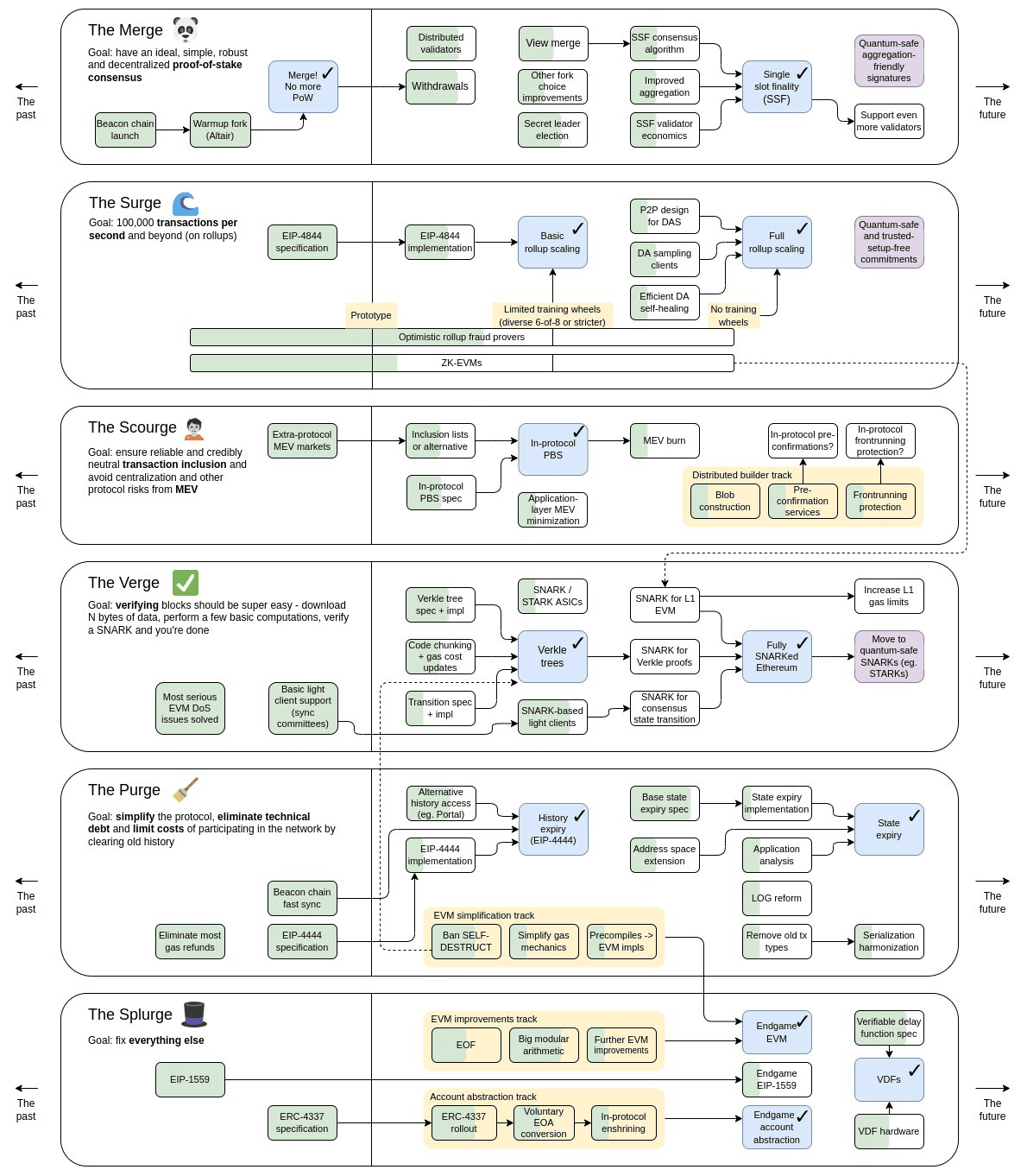
Although Ethereum is at the initial stage of transformation, its L2 ecosystem, using solutions for transaction aggregation, already demonstrates elements of a multi-modular approach. The interaction between the first and second levels largely defines the vision of modular architecture.
However, existing solutions, such as rollups, do not address the key scalability issue related to data availability. Rollups transmit transaction information to the main Ethereum network, where it is stored as calldata, leading to an increase in data volume and node requirements despite not being directly linked to the blockchain state.
Therefore, Ethereum provides a successful example of moving the transaction execution function outside of a single network, while also indicating the need for further research and development to improve data availability.
Development of the Technological Foundation
The development of relevant technologies plays a key role in supporting the security and enhancing the performance of modular networks, facilitating their development. Important innovations in this area include:
| Category | Description and Examples |
|---|---|
| Cross-chain technologies | Tools such as LayerZero and Chainlink’s CCIP provide convenient, fast, and secure data exchange between different blockchains. They are critical for modular systems that require efficient interaction between diverse layers. |
| Zero-knowledge proofs | This technology becomes key to solving data storage and access issues, especially after its integration into the blockchain began in 2021-2022. |
| Technical platforms | Toolkits like OP Stack, Cosmos SDK, Polygon SDK, and Celestia Rollkit make it easier and cheaper to launch new modular networks using existing infrastructure, lowering technical and financial barriers for developers. |
| Restaking | This concept allows validators to secure multiple networks simultaneously, simplifying the creation of their own consensus mechanism in modular networks and providing better security compared to Cosmos's parachain architecture. |
These technological advancements significantly simplify the process of creating modular blockchains and developing decentralized applications based on them, contributing to the formation of an extensive ecosystem, including rollup-as-a-service services, consensus layers, and sequencer providers.
Modular Blockchain Ecosystem
In the modular blockchain ecosystem, where individual layers can be integrated with components of other networks, solutions emerge for all primary and secondary functions. This ecosystem, more diverse compared to monolithic networks, covers various types of projects:
- Transaction execution agents;
- Data providers;
- Cross-chain interaction protocols;
- Data validity confirmation systems;
- Platforms and toolkits.
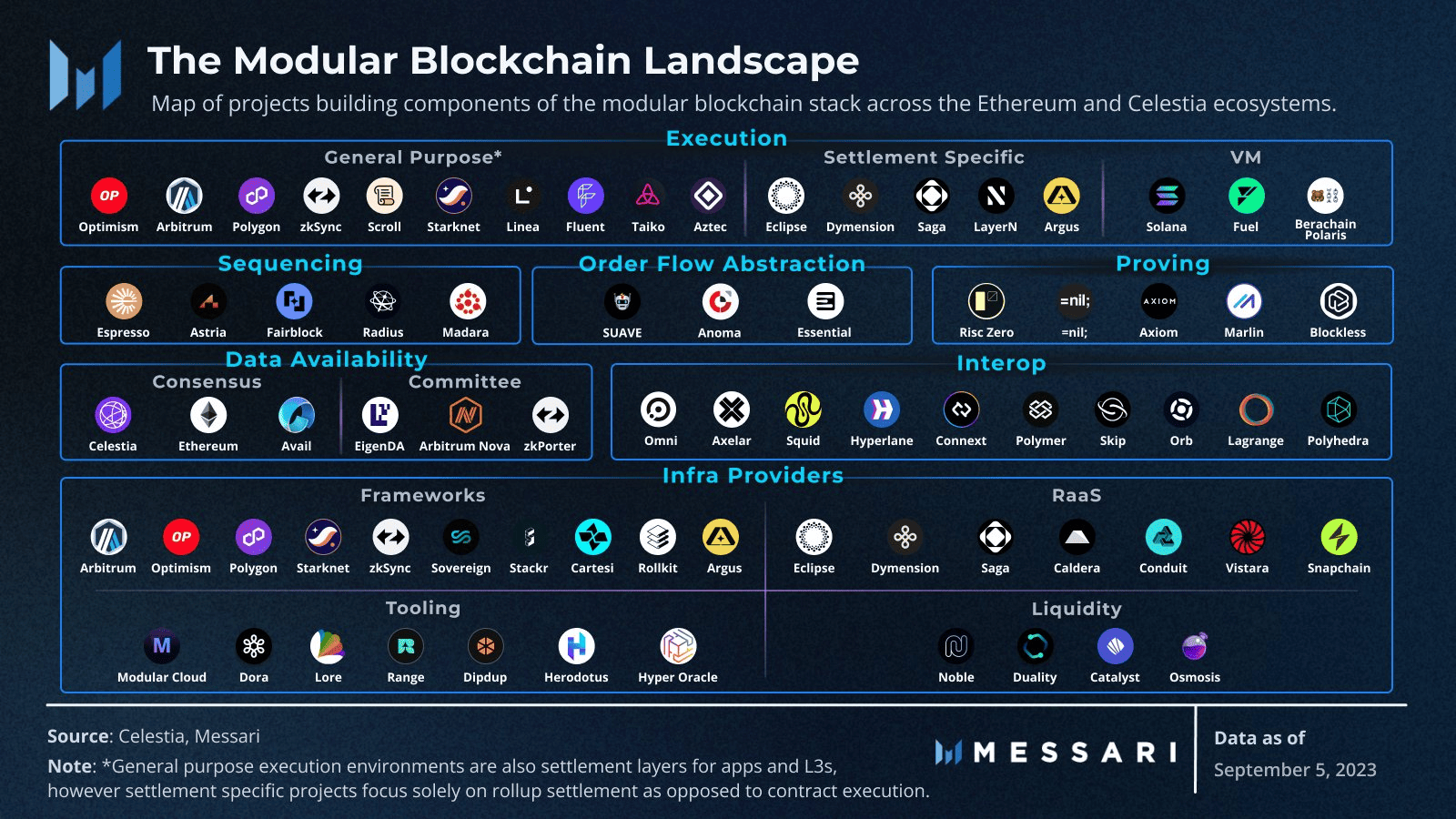
In this ecosystem, the foundation is made up of basic blockchains with their own consensus mechanisms, ensuring security and decentralization. Key players at this level include:
- Ethereum, serving as the basis for the L2 ecosystem but not modular by nature, interacting with the execution layer through smart contracts;
- Celestia, a fully modular network supporting independent layers and currently in the testing phase;
- Polygon's Avail, which provides consensus and data layers for modular networks, is also in the testing phase.
Systems like Polkadot and Cosmos are developing mutual security mechanisms and toolkits for development, thus also approaching modular structures.
As of September 2023, the market has not yet presented a fully functional modular blockchain capable of flexible integration of consensus, execution, and data layers. Celestia is the most advanced in this direction, but only the launch of a full-fledged network will show its effectiveness and practical value for developers.
Understanding Modularity Evolution
A year ago, debates on modularity focused on comparing modular and monolithic blockchains. But today, we witness the technical and conceptual evolution of this idea, as attention shifts from direct comparison to a deeper interaction and complementarity between different types of networks.
Each type of blockchain is adapted to perform specific tasks: for launching a decentralized application, an L1 network might be more convenient, whereas for more complex functions or creating an ecosystem like Frax, a network with inherited security might be more appropriate.
Solana, for example, is experiencing a renaissance, particularly in the DeFi sector, thanks to its ability to provide fast and low-cost transactions. Despite being monolithic and highly centralized, low fees for the DeFi sector are often a more critical criterion.
The next-generation modular infrastructure offers the flexibility to build blockchains from "Lego", borrowing ready-made modules, but not always are such composite networks the best solution. Therefore, monolithic networks will continue to have their place in the blockchain industry, emphasizing the importance of choosing the right architecture for each specific purpose.
